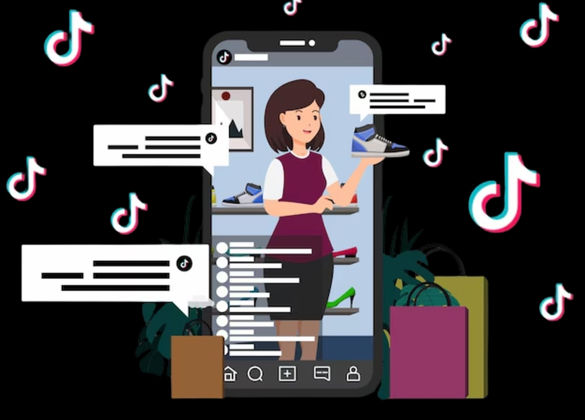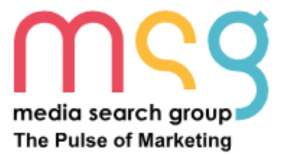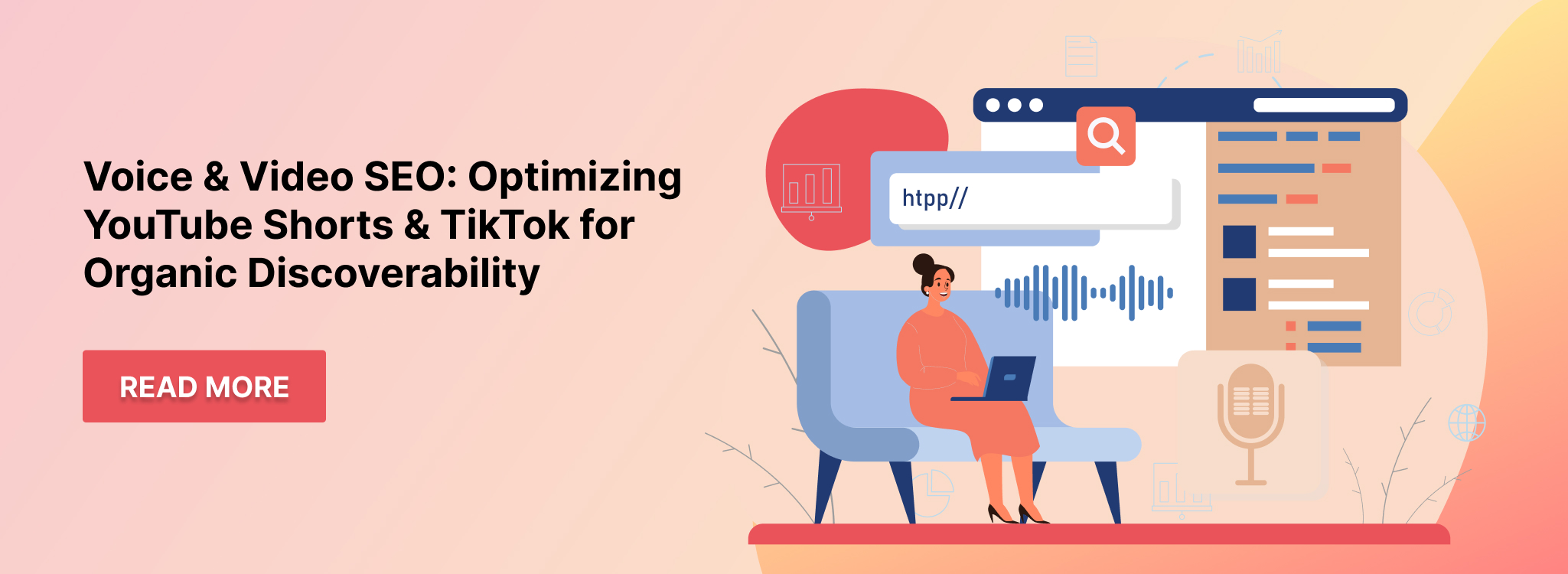Recently updated: October 4th, 2025
Search isn’t just about keywords and blue links anymore. It’s now a multi-sensory experience led by voice cues, vertical videos, and visual storytelling. And platforms like YouTube Shorts and TikTok are right at the center of this shift.
When someone searches “how to bake soft cookies in 1 minute” or “quick productivity hacks before 9 AM,” they’re just as likely to discover your content on YouTube Shorts or TikTok as they are on Google. But showing up in those feeds and getting found in search isn’t accidental. It takes strategic optimization.
This is not just video SEO anymore. It’s voice + video SEO. It’s about tuning your content to how people watch, listen, and search in 2025. If you’re creating short videos, managing content visibility, or offering SEO services, this guide will help you optimize for discoverability organically.
This guide walks you through the exact strategies to get your short-form videos seen, surfaced, and shared in today’s rapidly evolving search landscape.
The Rise of Short‑Form Video: A New SEO Frontier
 Short-form video has gone from a trend to the dominant language of the internet. In 2025, it’s not an exaggeration to say that if your brand isn’t showing up in vertical video feeds, you’re invisible to an entire generation of searchers.
Short-form video has gone from a trend to the dominant language of the internet. In 2025, it’s not an exaggeration to say that if your brand isn’t showing up in vertical video feeds, you’re invisible to an entire generation of searchers.
According to recent reports, over 90% of internet traffic is now driven by video and short-form is the fastest-growing format of all. TikTok alone commands more daily watch time than YouTube for Gen Z, while YouTube Shorts has surpassed 70 billion daily views globally. That’s not a content trend. That’s a behavioral shift.
What changed?
People now expect answers, inspiration, and entertainment in under 60 seconds.
And platforms are rewarding creators who deliver it.
But with this growth comes competition and that’s where voice and video SEO matters. Just posting a video isn’t enough anymore. You need to make sure it’s:
- Discoverable in TikTok and YouTube’s internal search
- Indexed in external engines like Google (yes, Shorts and TikToks can show in search results)
- Recommended by algorithms that favor engagement, context, and metadata
Here’s what else is changing:
- Micro-influencers outperform macro ones in engagement: 15% vs 3.86% on platforms like TikTok and Instagram.
- YouTube influencer marketing is projected to hit $2.35B this year in the U.S. alone.
- Short videos are now used for everything from product discovery to personal search, replacing traditional blog posts and static content.
What this means for SEO: Search isn’t just text-based anymore. It’s visual. It’s fast. It’s conversational. And it’s powered by video. Voice and video SEO is your toolkit to adapt.
Understanding YouTube Shorts SEO
YouTube Shorts might look effortless, quick cuts, catchy audio, swipeable content, but what performs well on the surface is often backed by meticulous SEO under the hood. If your goal is organic reach, Shorts demand the same strategic thinking as long-form content, just condensed.
Keyword‑Rich Titles & Descriptions
Titles on Shorts are more important than most people think. While Shorts autoplay in the feed, titles act as your anchor in YouTube search and on your channel page. A video titled “Productivity hack” won’t stand out. But “5 Productivity Hacks in 30 Seconds (That Actually Work)” hits both clarity and search intent.
Use keyword phrases people actually type like questions, how-tos, listicles. Some examples:
- “How to stretch before bed”
- “Easy lunch recipes under 10 mins”
- “AI tools that save time in 2025”
Keep your title under 50 characters and pack your description with semantically related terms. Even though YouTube Shorts don’t rely heavily on descriptions within the feed, the algorithm still reads them for indexing and surfacing.
Strategic Hashtag Use
YouTube uses hashtags to categorize Shorts. At a minimum, include #Shorts in every upload. Beyond that, 3-5 relevant, content-specific hashtags help YouTube understand your topic and place your content into the right discovery streams.
For example:
- A video about meal prep: #MealPrep #HealthyEating #Shorts
- A quick AI tool review: #AItools #ProductivityHacks #Shorts
Avoid generic tags like #fun or #viral, they’re too broad and may confuse the algorithm.
Thumbnails & Retention Hooks
While Shorts typically auto-play, YouTube still uses thumbnails on channel pages, playlists, and when a Short appears in traditional search results. So, design a clear, high-contrast visual thumbnail even if you think no one will see it.
More importantly, focus on the first 1-2 seconds of the video, this is your hook. Use motion, text overlays, or voice prompts like “Stop scrolling if…” to grab attention instantly.
Engagement Signals Drive Visibility
YouTube’s algorithm tracks signals like:
- Watch-through rate
- Rewatches
- Comments and shares
- Channel interaction over time
This is why optimizing for search isn’t enough, you also need to optimize for human behavior. A Short that holds attention for 15+ seconds and gets shared is more likely to rank higher and get looped in the recommendation engine.
Cracking TikTok’s Discoverability Algorithm
TikTok isn’t just a social media app anymore; it’s a full-blown search engine. People now ask TikTok how to cook salmon, how to study for exams, and what to wear in Dubai in August. The platform has become a hybrid of entertainment and intent-driven exploration. That’s where TikTok SEO comes in.
To get discovered organically, your content needs to speak to both the user’s curiosity and the algorithm’s logic. Here’s how to optimize every post for maximum reach.
TikTok‑Style Content & Edutainment
 TikTok thrives on authenticity. Over-produced videos often get skipped, while raw, value-packed clips hold attention. This is where “edutainment” comes into play, that is educational content wrapped in an entertaining format.
TikTok thrives on authenticity. Over-produced videos often get skipped, while raw, value-packed clips hold attention. This is where “edutainment” comes into play, that is educational content wrapped in an entertaining format.
Examples of edutainment TikToks:
- “3 public speaking hacks from a TEDx coach” (shown with casual visuals)
- “What your coffee order says about your work style” (narrated with humor)
- “AI tools that will make you 2x faster this week” (with screen recordings)
The best-performing TikToks often:
- Deliver value in under 30 seconds
- Use a voiceover or text narration that says the keyword clearly
- Get to the point in the first 2-3 seconds
Pro tip: Speak your target keyword early in the video, TikTok transcribes it for SEO indexing.
Trend Riding & Hashtag Strategy
Trending sounds, challenges, and formats can amplify your reach, but only if they align with your message. Avoid using unrelated trends just for exposure. Instead, remix them creatively to stay relevant while staying on-topic.
Hashtag SEO still matters:
- Use a mix of broad and niche hashtags (e.g., #smallbusinesstips, #tiktokseo, #remoteworklife)
- Avoid spammy tags like #fyp or #viral, they rarely help, and sometimes hurt
- Add location-based hashtags if targeting local discoverability (e.g., #DubaiBusiness, #NYCStyle)
TikTok also scans your video description, captions, and spoken words to understand context. Align all three.
Short‑Form SEO Tools
While TikTok doesn’t provide the same level of SEO tooling as YouTube, there are external platforms that can help:
- EmbedSocial lets you track performance and embed TikToks to extend discoverability beyond the app
- Trend discovery tools (like TrendTok, Vidooly) can help identify what’s rising before it peaks
- Tools like CapCut now include built-in text overlays and auto-captioning to support accessibility and indexing
TikTok SEO is still evolving, but the core principle remains the same: make content that feels native to the platform, while being intentional about discoverability.
Video SEO Strategy: Cross‑Platform Synergies
Publishing a great short-form video is only half the battle. The real advantage comes when you think beyond the platform, repurposing your content strategically across YouTube Shorts, TikTok, Instagram Reels, and even Google Discover.
But this isn’t a copy-paste game. Each platform has its own language, algorithm preferences, and SEO structure. Here’s how to maximize your reach through cross-platform video SEO.
Repurposing Across YouTube Shorts, TikTok & Reels
 The beauty of vertical video is that one shoot can turn into content for multiple channels. But to win on each, you must optimize for each:
The beauty of vertical video is that one shoot can turn into content for multiple channels. But to win on each, you must optimize for each:
- Start with TikTok: The most creative-friendly editing tools (CapCut, filters, effects) and raw performance insights.
- Adapt to YouTube Shorts: Focus more on keyword-rich titles and align content with YouTube search behavior.
- Use Reels for Instagram: Prioritize aesthetic quality and engagement (likes, saves, shares).
Repurpose smarter:
- Record in high resolution (9:16 format) without platform watermarks.
- Save the raw footage before uploading.
- Edit slightly for each platform to match its vibe and algorithm triggers.
This creates what marketers call “content compounding”, multiple organic traffic streams from a single video concept.
Platform‑Specific Customization
Each algorithm weighs different factors. Here’s how to customize accordingly:
| Platform | Prioritizes | SEO Tips |
| TikTok | Watch time, replays, sound trends | Speak keywords aloud; use trends with relevance |
| YouTube Shorts | Retention rate, title relevance, engagement | Use keyword phrases in title & description |
| Instagram Reels | Shares, saves, profile visits | Use strong CTA overlays; optimize captions for curiosity |
Avoid reposting with visible watermarks (like TikTok logos on Shorts). YouTube’s algorithm, in particular, demotes watermarked content.
Use of SEO Tools
Don’t just guess what works; measure it.
Tools to help:
- TubeBuddy / VidIQ: For optimizing Shorts titles and tags
- SEMrush / Ahrefs: For identifying short-form keywords people search for
- CapCut & Captions: For generating text overlays that boost on-screen keyword visibility
- Analytics dashboards (YouTube Studio, TikTok Pro): To track watch-through rates and drop-off points
By combining these tools, you can build a video SEO feedback loop: publish, analyze, optimize, and repeat. The more platforms you strategically show up on, the more your content and your brand become discoverable organically.
Voice SEO: Enhancing Discoverability with Audio
When we think about SEO, we often focus on titles, tags, and text, but voice is now a critical layer in how videos get indexed, understood, and surfaced. Both YouTube Shorts and TikTok automatically transcribe your audio behind the scenes. That means the words you speak in a video can act as searchable content, even if you never type them out.
If you’re not optimizing your spoken content, you’re leaving organic reach on the table.
Why Spoken Keywords Matter
Here’s what platforms do with your voice:
- YouTube generates captions (even when you don’t upload them)
- TikTok uses audio transcription to inform For You page categorization and in-app search results
- Google may surface video results with matching voice transcription in search snippets
So, when you say “Here are 3 video SEO tips for small businesses,” that phrase becomes part of the discoverable data.
In short: your voice is your metadata.
How to Use Voice Strategically in Video SEO
 To improve voice-based discoverability:
To improve voice-based discoverability:
- Say your target keyword early within the first 3-5 seconds
- Repeat the key phrase at least once naturally
- Use spoken CTAs like “Follow for more YouTube SEO tips” or “Save this TikTok SEO checklist”
- Avoid filler words in your intro (like “So, umm, basically…”), get straight to the point
For example, if you’re making a Short about keyword tools:
Don’t start with: “Hey guys, today I just wanted to quickly talk about something cool I found…”
Do start with: “Here are 3 free keyword research tools for TikTok and YouTube Shorts.”
That one sentence improves your chances of being found via voice-powered search.
Bonus: Use Captions to Reinforce Voice SEO
Platforms often overlay auto-captions, but you can customize your own to match what you say and add keyword-rich context.
- Use large, readable fonts (especially on mobile)
- Highlight important terms (“video SEO,” “YouTube discoverability”)
- Sync text timing with your voice for better retention and comprehension
The best voice SEO is invisible to the viewer but fully legible to the algorithm.
Engagement, Analytics & Iteration
SEO doesn’t stop when you hit “publish.” In short-form video, performance is directly tied to how people engage and how you respond to that data. YouTube Shorts and TikTok both reward content that keeps viewers watching, interacting, and coming back. But the way they track success is different from traditional search.
To grow consistently, you need to measure, learn, and adapt your strategy based on real engagement signals.
Key Metrics That Drive Discoverability
Here’s what both platforms prioritize behind the scenes:
| Metric | Why It Matters |
| Watch-through rate | Measures how long people stay till the end |
| Repeat views | Indicates value and entertainment |
| Likes & Shares | Signals emotional resonance and spread |
| Comments | Drives social proof and deeper reach |
| Profile clicks | Suggests brand or creator interest |
The algorithm uses this data to determine whether your video should be:
- Boosted on the For You page (TikTok)
- Suggested in Shorts shelf and Search (YouTube)
- Recommended as related content
So, while SEO helps you get discovered initially, engagement keeps you visible.
How to Analyze Performance and Iterate
Once a video goes live, your job shifts from creation to calibration.
Start by asking:
- Did the video hold attention past 5 seconds?
- Which part had the biggest viewer drop-off?
- Are people commenting, or just scrolling?
- Did similar topics perform better last week?
Use platform-native analytics tools:
- YouTube Studio → Analytics → Shorts tab
- TikTok Creator Tools → Video Insights
Look for trends across videos, not just one post. Maybe your audience prefers tips over tutorials. Or you get more traction when using voiceover vs direct-to-camera.
Refining Your SEO Based on Feedback
Use insights to fine-tune future posts:
- Update your titles if the video isn’t getting discovered
- Refresh descriptions and hashtags to align with trends
- Double down on formats that get the most replays or saves
And don’t hesitate to re-upload a better version of a video that underperformed. Small changes in structure, hook, or voice can yield dramatically different results.
The most successful video SEO strategies aren’t static. They evolve with every post, every comment, and every click.
2025 Trends & Future of Short‑Form SEO
The short-form video landscape isn’t just growing; it’s evolving in real time. In 2025, we’re seeing platforms shift from being entertainment-first to search-first ecosystems. That means video SEO isn’t optional, it’s foundational.
Creators and brands that keep up with these trends will not only get more reach today, but will own the algorithm tomorrow.
Emerging Trends Reshaping Video SEO
 Search Intent is Taking Over the Feed: TikTok recently announced that over 40% of Gen Z uses TikTok as their primary search engine. Queries like “easy 3-ingredient meals” or “best skincare for oily skin” are replacing traditional Google searches and they’re answered with videos, not links.
Search Intent is Taking Over the Feed: TikTok recently announced that over 40% of Gen Z uses TikTok as their primary search engine. Queries like “easy 3-ingredient meals” or “best skincare for oily skin” are replacing traditional Google searches and they’re answered with videos, not links.- YouTube Shorts Is Becoming a Search Engine: YouTube is leveraging its long-form search advantage to index Shorts alongside regular videos. That means your Short can show up when someone Googles a question, if it’s SEO-optimized.
- Voice Search and Captions Are Now Ranking Signals: Platforms transcribe everything. In 2025, spoken keywords, voice-based search prompts, and AI-generated captions help determine who sees your video, when, and where.
- Micro-Influencers + SEO = Organic Powerhouse: Brands are shifting ad spend from macro-celebrities to creators with smaller followings but higher engagement. When paired with SEO, these creators outperform paid campaigns by being more discoverable, relatable, and persistent in search results.
- SEO Tools Are Catching Up to Short-Form Needs: Tools like TubeBuddy, TrendTok, and TikTok Creative Center now provide insights not just on what’s trending—but on what’s ranking.
What This Means for You
The future of short-form SEO is layered:
- It’s algorithmic (engagement + retention)
- It’s semantic (spoken keywords + captions)
- It’s intent-driven (matching user search behavior)
And it’s only getting smarter.
Whether you’re a brand, marketer, or solo creator, this is your moment to build long-term visibility; not just by going viral, but by being findable when it matters most. Shorts and TikToks that are optimized today will keep surfacing weeks or months from now, as users continue to search with their thumbs and voices.
Actionable Cheatsheet
Let’s turn everything we’ve covered into a quick-reference checklist. Whether you’re optimizing YouTube Shorts, TikToks, or both, this cheat sheet will help you stay focused on the essentials that actually drive organic discoverability.
Before Publishing
 Choose a keyword-friendly video title (under 50 characters)
Choose a keyword-friendly video title (under 50 characters)- Write a description using natural language and related terms
- Add 3-5 relevant hashtags (including #Shorts for YouTube)
- Speak your main keyword aloud in the first 5 seconds
- Include voice-based CTAs (e.g., “Follow for more SEO tips”)
- Add manual captions with keyword emphasis and clear fonts
- Remove any platform watermarks (especially when cross-posting)
Content Structure
- Open strong, hook viewers in the first 2 seconds
- Keep videos between 15-45 seconds for optimal watch-through
- Use loop-friendly endings (restarts feel seamless)
- Maintain a consistent format and tone across posts
Platform-Specific Optimization
- Use YouTube Shorts titles with high-intent phrases (e.g., “How to…”)
- Align TikTok content with trending sounds + niche hashtags
- Optimize thumbnails for YouTube Shorts (even if not required)
- Customize visuals/captions per platform (don’t just repost)
Post-Publish Optimization
- Monitor performance in YouTube Studio / TikTok Analytics
- Track watch-through rate, shares, and profile clicks
- Identify top-performing keywords, formats, and topics
- Re-upload improved versions if needed
Tools to Use
- TubeBuddy / VidIQ – YouTube Shorts keyword & engagement tools
- TikTok Creative Center – Trend discovery & performance insights
- CapCut / Captions – Custom captioning with keyword overlays
- Google Analytics (with utm_source) – Track traffic from embeds/search
This checklist isn’t static. Keep refining it based on what your audience responds to and what platforms prioritize as their algorithms evolve.
Consistency + optimization = lasting discoverability.
Conclusion
The way people discover content has changed. It’s no longer just about Google rankings or social followers. In 2025, attention lives inside feeds, search bars, and conversations, and short-form video is at the center of it all.
If you want your content to be found, recommended, and remembered, you need to optimize for both voice and video. That means thinking about what you say, how you say it, and how your video is structured from title to caption to spoken word.
Platforms like YouTube Shorts and TikTok aren’t just entertainment apps. They are now intent-driven ecosystems where people go to learn, shop, solve problems, and get inspired.
And the best part?
Unlike traditional SEO, short-form video optimization gives you faster feedback loops, greater reach, and the ability to show up in multiple discovery paths, from YouTube search to Google snippets to in-app recommendations.
To summarize:
- Start with intent-first content that answers real questions
- Speak your keywords aloud and reinforce them with captions
- Use platform-specific SEO tactics (titles, hashtags, descriptions)
- Repurpose across platforms smartly (without watermarks)
- Measure everything and iterate relentlessly
Voice + video SEO is not a nice-to-have anymore. It’s the new standard for visibility in the age of algorithmic discovery. The brands and creators who embrace this shift now won’t just get more views. They’ll build lasting relevance across the platforms that shape how the world finds content.
Frequently Asked Questions
How does voice impact SEO for YouTube Shorts and TikTok?
Voice plays a major role in short-form SEO. Both YouTube and TikTok auto-transcribe your audio to better understand what your content is about. When you speak your main keyword early in the video, it increases your chances of being surfaced in search and suggested feeds. Your spoken words are now part of your metadata.
Can YouTube Shorts show up in Google search results?
Yes. YouTube Shorts can appear in Google search results, especially if they’re optimized with relevant keywords, proper titles, and structured metadata. Shorts that answer common questions or how-tos are more likely to be indexed and shown as part of rich results.
Do hashtags really help TikTok SEO?
They do when used correctly. TikTok uses hashtags to understand the topic and context of your video. A mix of broad and niche hashtags helps position your content in the right discovery paths. However, avoid spammy or irrelevant tags like #fyp or #viral, which often hurt more than help.
How can I track performance of Shorts and TikToks for SEO?
Use platform-native analytics tools like YouTube Studio and TikTok Creator Tools to monitor views, watch time, and engagement. Track performance trends over time to see which formats and topics are working. For web embeds or external traffic, use UTM parameters like utm_source=tiktok or utm_source=youtube.
What’s the ideal length for a short-form video?
The sweet spot is between 15 and 45 seconds. That range is long enough to deliver value, but short enough to hold attention and loop effectively. If a viewer re-watches your content or watches till the end, that signals quality to the algorithm.
Can I repurpose one video across all platforms?
Yes with tweaks. Record your video once, then adapt it per platform. Remove watermarks, adjust the caption style, and tailor the hashtags. A single well-crafted video can drive traffic from TikTok, Shorts, Reels, and even Google, if optimized properly.
Are auto-captions enough for video SEO?
Auto-captions help, but they’re not always accurate. Adding your own manual captions with clear, bold text improves accessibility, retention, and keyword emphasis. Custom captions also give you control over timing and formatting, which can improve performance.
Is short-form video SEO different from traditional video SEO?
Yes. Traditional video SEO often focuses on thumbnails, long descriptions, and playlists. Short-form SEO is faster, more intent-driven, and relies heavily on voice, hooks, and in-feed discoverability. The optimization window is tighter, but the rewards are quicker too.


